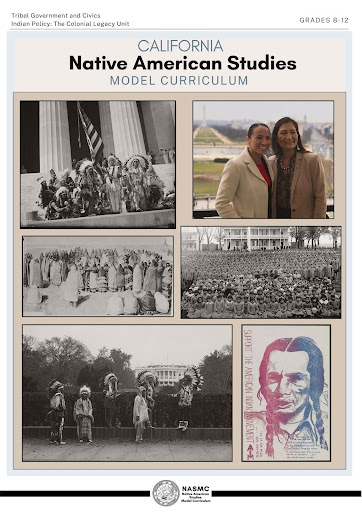Overview
Free Resources!
Tribal Government and Civics

Author(s) : Hillary Manion (Modoc/Klamath descendant)
Lesson partner: Rebecca Lowry and Maggie Peters, Humboldt County Office of Education
Grade(s) : 8-12th Grades
Suggested Amount of Time :
Curriculum Themes:
- History
- Cultural Strengths
- Law/Government
- Relationship to Place
- Cross Curricular Integration
Learning Goals
Students will analyze the implications of settler colonialism
Students will analyze the pros and cons of Federal Government's Indian policy
Students will learn important events within U.S. history in regards to Native Americans and tribes from the Doctrine of Discovery, European Arrivals, U.S. Constitution, Federal Treaties with Tribes, Westward Expansion, American Indian Boarding School Era, American Indian Movement, and Indian Self-Determination Act.
Students will analyze how Native American peoples were disrupted, displaced, and significantly altered by the Westward Expansion, settler colonialism, and governmental policies and practices from the 1800s to the 2000s.
Students will plan and design activities that address the issue emphasizing tribal cultural values, leadership principles, and civic responsibilities.
Students will have opportunities to learn from and engage with tribes, tribal communities, and tribal organizations.
Students will increase civic education learning skills of Native and non-Native youth so that they may become more active problem solvers within their own communities and the wider community.
Students will participate in collaborative learning to partner tribes and organizations to conduct effective service learning.
Students will learn the foundational understanding of tribal, state, and federal governments, with a particular focus on Native Americans' roles as citizens within these three communities.
Students will explore the unique position that Native Americans hold in the United States, as they potentially belong to tribal, state, and national communities, whereas most U.S. citizens are only part of state and national communities.
Students will explore the interactions and impacts of tribal, state, and federal governments on one another.
Students will engage in civics education, design thinking, and service learning projects that explore issues that face them and their communities directly in regards to U.S. history and tribal sovereignty.
Students will evaluate the Federal Government's Indian policy during the latter part of the 19th century and the 20th century.
Students will develop skills to analyze primary documents, maps, letters, photographs, paintings, and digital media.
Lesson Overview
The Tribal Government and Civics units aim to provide an understanding of tribal, state, and federal governments, with a particular focus on Native Americans' roles as citizens within these three communities. Native Americans hold a unique position in the United States, as they potentially belong to tribal, state, and national communities, whereas most U.S. citizens are only part of state and national communities.
This unit will delve into the interactions and impacts of these governments on one another. This unit of Indian Policy: Colonial Legacy will share important events from the Doctrine of Discovery, European Arrivals, U.S. Constitution, and Federal Treaties with Tribes. Additionally, it will explore how the diverse ways of life of Native American peoples were disrupted, displaced, and significantly altered by the Westward Expansion, settler colonialism, and governmental policies and practices from the 1800s to the 2000s.
Ultimately, the unit will support California youth to engage in civics education, design thinking, and service learning projects that explore issues that face them and their communities directly. The youth will plan and design activities that address the issue emphasizing tribal cultural values, leadership principles, and civic responsibilities.
There will be opportunities for projects to engage with tribes, tribal communities, and tribal organizations. Our major goals are to increase civic skills of Native and non-Native youth so that they may become more active problem solvers within their own communities and the wider community. Additionally, students will have opportunities to participate in collaborative learning to partner tribes and organizations to conduct effective service learning.
Teacher Background
Educators Guide and Videos to the Essential Understandings of California Indian History and Culture
Please take time to read through this document and watch these videos to learn from California Indian cultural bearers as they teach the Essential Understandings of California Indian History and Culture. (https://bit.ly/NASMC_EU)
Essential Understanding 1: Great Diversity Among Tribes (EU1 Video) https://bit.ly/NASMC_EU1
Essential Understanding 2: Diversity Among Identity (EU2 Video) https://bit.ly/NASMC_EU2
Essential Understanding 3: Native Traditional Beliefs (EU3 Video) https://bit.ly/NASMC_EU3
Essential Understanding 4: Policies that Affected Tribes (EU4 Video) https://bit.ly/NASMC_EU4
Essential Understanding 5: Reservations (EU5 Video) https://bit.ly/NASMC_EU5
Essential Understanding 6: History from a California Indian Perspective (EU6 Video) https://bit.ly/NASMC_EU6
- Essential Understanding 7: Tribes Have Sovereign Powers (EU7 Video) https://bit.ly/NASMC_EU7